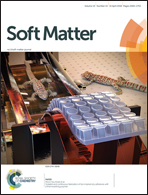Magnetophoretic induced convective capture of highly diffusive superparamagnetic nanoparticles†
Abstract
Micro-magnets producing magnetic field gradients as high as 106 T m−1 have been used to efficiently trap nanoparticles with a magnetic core of just 12 nm in diameter. Particle capture efficiency increases with increasing particle concentration. Comparison of measured capture kinetics with numerical modelling reveals that a threshold concentration exists below which capture is diffusion-driven and above which it is convectively-driven. This comparison also shows that two-way fluid–particle coupling is responsible for the formation of convective cells, the size of which is governed by the height of the droplet. Our results indicate that for a suspension with a nanoparticle concentration suitable for bioassays (around 0.25 mg ml−1), all particles can be captured in less than 10 minutes. Since nanoparticles have a significantly higher surface-to-volume ratio than the more widely used microparticles, their efficient capture should contribute to the development of next generation digital microfluidic lab-on-chip immunoassays.



 Please wait while we load your content...
Please wait while we load your content...